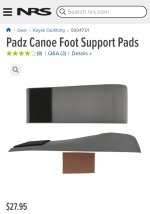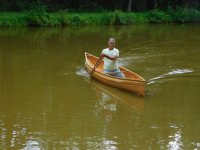I'm a 99% sitter. I went for a paddle this weekend and kneeled for a bit. As usual I find the most uncomfortable part of kneeling to be my ankle joints. When I kneel my toes are pointed toward the stern with the top of my foot in contact with the hull and after a while this stretched position begins to bother me.
I don't think I've ever tried kneeling with my feet vertical (toes touching the bottom of the hull) but that doesn't seem like it would be very comfortable either.
So what foot position do you kneelers use and how comfortable is it? Does anyone use foam supports under the ankle to remove some strain and relax that joint?
Alan
I don't think I've ever tried kneeling with my feet vertical (toes touching the bottom of the hull) but that doesn't seem like it would be very comfortable either.
So what foot position do you kneelers use and how comfortable is it? Does anyone use foam supports under the ankle to remove some strain and relax that joint?
Alan


